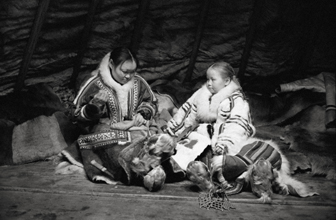A Bride of the Seventh Heaven
Anastasia Lapsui / Markku Lehmuskallio
Finnland 2003

|
" Arsenal 06.02. 21.30 |
Produktion: Millenium Film Ltd. u.a.
Weltvertrieb: Millennium Film Ltd.,
Patruunantie 8, FIN-05200 Rajamäki, Finnland
Tel.: (358-9) 6860 466, Fax: 6860 4660
E-mail: kristiina.pervila@millenniumfilm.fi
Ausstattung: Markku Lehmuskallio,
Anastasia Lapsui
Buch, Kostüme: Anastasia Lapsui
Kamera: Johannes Lehmuskallio
Schnitt: Juho Gartz
Darsteller: Angelina Saraleta, Wiktoria Hudi,
Ljuba Filipowa, Jewgeni Hudi
Format: 35mm (von Super16), 1:1.85, Farbe
Länge: 85 Minuten, 24 Bilder/Sek.
Sprache: Nenet
The film was made in 2002 and 2003 with the assistance of the local Nenets on location in the tundra of the Yamal Peninsula. They all are ordinary people, amateurs at acting. The leading role is that of an old Nenet woman called Syarda, her full name being Numd Syarda. The word Num means heaven and is also the name of the highest god of the Nenets. Syarda means tied to or imprisoned. So Numd Syarda literally means tied or spliced to Num. The film is about loneliness, about a lonely old woman who recounts her life to a blind girl called Ilne. Her name, Ilne, means giver of life. In the Nenet culture, both in the past and still today, a girl child can be offered to the god Num before or after her birth. Normally, it takes place after her birth, once the gender is known. She may be pledged to the god for three, four or five times seven years, or even for her whole life. It begins at her birth. When the time is up, the woman may take an earthly husband as her lifetime partner. In the film, Syarda was pledged to the god before her birth, based on a shaman’s prediction. The script is by Anastasia Lapsui and is based on her own experience. As a young girl, she was blind for some years and often visited an old woman who lived alone in the neighbouring tepee. They were friends and the old woman told Anastasia Lapsui about her life betrothed to a god. The film is her story. Anastasia Lapsui, Markku Lehmuskallio
Anastasia Lapsui, geb. 1944 in Yar Sale/UdSSR. Zunächst Radiound Zeitungsjournalistin. 1990 ein erstes Drehbuch. 1993 Beginn der Zusammenarbeit mit
Markku Lehmuskallio, geb. 1938. Ab 1974 Filme, im Forum: Das Opfer – Ein Film über den Wald (1999), Sieben Lieder aus der Tundra (2000), Elämän äidit/ Mothers of Life (2002).